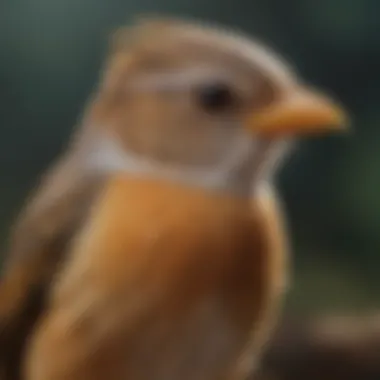Bird Chirping Identifier: Understanding Avian Communication


Intro
Understanding bird chirps and songs offers key insights into avian communication. Each bird produces unique vocalizations that reveal important information about their behavior, mood, and health. Unraveling these sounds enriches interactions between bird owners and their feathered companions.
Familiarizing oneself with the various chirps contributes to better care and appreciation of pet birds. As we explore the methods of identifying these sounds together in this article, we reveal the direct connection between vocalization and a bird's well-being.
Care Tips
Daily attention to your bird's environment and routine lays the foundation for identifying their chirping behavior. Adjustments in care can result in observable changes in vocalizations.
Daily Care Routines
- Regular Interaction: Spend a consistent amount of time interacting with your bird to foster comfort. This develops trust and encourages vocalizations.
- Feeding Schedule: Maintain a regular feeding schedule. Hunger can influence chirps, which could signal a need for attention or need.
- Observation of Patterns: Note any changes in your bird’s chirping frequency or pattern. It could signify emotional or health-related states.
Cage Setup and Maintenance
Creating a suitable habitat is crucial. Your bird's cage must allow for movement and be well-ventilated. Regular cleaning and updating the cage helps maintain a stress-free environment. A cluttered although clean cage often leads to anxiety and excess chirping.
Hygiene and Cleaning Practices
Ensure to clean your bird's cage frequently to prevent illness. Use appropriate bird-safe cleaners, change bedding regularly, and wash food and water containers each day. A hygienic cage promotes health and minimizes distress vocalizations.
Seasonal Care Adjustments
Birds often react to environmental changes. Adjust your bird's care routines according to seasonal shifts. Provide additional warmth during winters or ventilation during summer months, as these factors can affect your bird's vocal health.
Behavioral Insights
Understanding your bird's body language further helps in assessing their vocal outputs. Body language can serve as an insight into emotional states.
Understanding Bird Body Language
Birds utilize body postures, feather movements, and eye expressions to convey emotions. Recognizing this can sharpen skills in interpreting their chirps.
Common Behavioral Issues and Solutions
- Boredom: Increased vocalizations are often due to boredom. Provide more toys or stimulation periodically.
- Stress Responses: Aggressive chirping signals distress. Ensure a calm environment to lessen anxiety.
Positive Reinforcement Techniques
Offering treat rewards for positive chirping can enhance communication. Gradually the bird learns the context of vocalized encouragement, fostering a healthier bond.
Social Interaction Needs
Birds are social beings. Regular interaction can alter production of certain calls. Isolated birds frequently vocalize out of loneliness. Try engaging multiple times daily, or consider a companion bird if feasible.
Nutrition Guides
The diet greatly impacts overall bird health which consequently may reflect in chirp quality and quantity. A varied yet balanced surplus of fresh foods fosters well-being.
Essential Diet Components
Birds thrive on well-balanced diets substance-rich. Include seeds, pellets, fruits, and greens in their meals.
Safe and Toxic Foods
Know safe foods like carrots or apples, and be aware of harmful items such as avocado or chocolate.
Supplements and Treats
Supplements enhance overall well-being. Pellets sometimes require enhancement with little treats or fruits to create enjoyment, which in part leads back to improved ergosound interaction.
Feeding Strategies for Different Species
Every species has nuanced dietary requirements. Research's strict adherence to what's suitable avoids health issues.
Wellness and Health
The health of your bird directly connects to its capacity to communicate. Regular monitoring protects your bird from setbacks.
Routine Health Checkups
Schedule regular veterinary visits for physical check-ups. Professionals can detect underlying problems influencing chirping habits.
Identifying Symptoms of Illness
Observe changes in your bird’s vocalization correlated with symptoms. Whistling excessively can indicate unease but vary by species.
Preventative Care and Vaccinations


Vaccines are essential for the health. Preventative care minimizes illness risk.
Mental and Emotional Well-being
Birds require mental and emotional attention. Interact, play, and engage, so they maintain a balanced temperament which aids healthy vocal behaviors.
Enriching Activities
Playing and variety help stimulate mental activities in birds. Enrichment directly made effects the audible output a bird generates.
Toys and Playtime Ideas
Toys infuse excitement. Use various types, such as foraging or audio toys capable of mutual interaction balanced experience.
Training and Tricks
Training motivates mental challenges racial to chirping improvement by routine practice of mimicry.
Outdoor Activities and Interaction
Supervised outdoor time can be invigorating. Fresh air coupled contributes to changes in communication behaviors.
DIY Projects for Mental Stimulation
Create personalized toys using homemaking and rehabilitation tips boosting creativity and playful tenor.
> Proper identification of bird chirps allows owners to deepen their connection with their pets. Considering every phase of care and engagement fosters a lasting avian friendship enriched by clear communication and understanding.
When handled with knowledge, your pet bird transforms from a simple companion into an engaging partner. Delve into each aspect operationally and manage chirping through clear guidelines that build meaningful relationships.
Preamble to Bird Chirping Identification
Understanding avian communication through bird chirping identification holds a significant place in enhancing our connection with birds. This part delves into the nuances of why recognizing bird sounds is more than just an auditory exercise; it’s a way to enrich the bond between humans and their feathered companions.
Understanding Bird Vocalizations
Birds use a varied range of vocalizations that serve different purposes. From clear and melodious songs designed to attract mates to simple chirps that alert one another to danger, each sound embodies a specific communicative intent. Observing and understanding these sounds requires careful attention and enthusiasm. Research indicates that a well-rounded knowledge of bird vocalizations can lead to better care and improved interactions among pet bird owners.
When bird owners identify vocalizations accurately, they can better respond to their birds' needs. For instance, a distressed sound could signify discomfort or a need for attention. Conversely, rhythmic songs often indicate contentment. Fragmented sounds could show confusion or a search for companionship. Thus, recognizing these vocal nuances enables preventable issues and creates a happier living environment for both the bird and owner.
Importance of Identifying Bird Sounds
Identifying what a bird communicates through its chirp or call is fundamental for several reasons. Firstly, it helps owners comprehend their bird’s social and emotional climate. Understanding a bird’s well-being involves not only recognizing their physical cues but also decoding their sounds.
Secondly, becoming proficient at identifying bird sounds can engage owners actively in their bird’s life. A well-informed bird parent can anticipate actions or mood changes based solely on their bird's vocalizations. Moreover, documenting these sounds contributes to more extensive studies on bird communication and behavior.
Ability to distinguish between various sounds serve not just personal needs but also contribute to broader ecological understanding.
In tandem with increasing owner awareness, a focus on sound identification may enhance the collective knowledge on avian health. Increased happiness observed in companion birds correlates with understanding their sound behavior. By fostering such an environment, owners are likely to contribute positively to avian communities, benefiting their pet species overall.
The Basics of Bird Chirping
Understanding the basics of bird chirping plays an essential role in grasping avian communication. Bird sounds serve many purposes, from attracting mates to defending territory. A thorough comprehension potential allows pet bird owners to relate more closely with their feathered companions. Moreover, knowing common sound types provides insight into a bird's emotional state, health, and interactive behavior.
Types of Bird Sounds
Chirps
Chirps are short, high-pitched sounds made by various species, including pet birds and wild birds. These sounds often indicate N’asocial interaction. Chirps can serve as signaling tools to alert fellow birds or their owners to their presence.Deeply, chirps can be associated with excitement as well as displeasure. The frequency and intensity of chirps can denote different emotions or situations. It distinguishes itself as a beneficial choice within this article, emphasizing how learning about these sounds enhances connections with birds. However, the downside can be their frequently repetitive nature, hinting at boredom or dissatisfaction, making it important for owners to recognize this aspect.
Songs
Songs are elaborate vocalizations and typically feature melodious patterns that vary from species to species. Unlike chirps, songs can last longer, comprised of multiple notes and phrases. This complexity allows birds to express a broader emotional range, making them crucial for mating calls and territorial claims. Hence, learning these sounds is particularly beneficial for understanding a species better. However, identifying songs can sometimes be challenging due to overlapping notes and environmental interference, requiring a discerning ear and time to filter through sounds in the surroundings.
Calls
Calls serve a functional role and tend to be shorter but can convey urgent messages. They often communicate alarm or signal general contact among birds. Therefore, mastering this type of sound helps owners understand when their birds may feel threatened or uneasy. The key characteristic of calls is their versatility; they can indicate various situations. In this regard, calls contribute significantly to overall bird response. The unique feature lies in that calls may vary in tone to express different meanings based on scenario. One major disadvantage is that some calls sound very similar among species, often leading to confusion for those not practiced in birdwatching.
What Do Different Sounds Mean?
To truly appreciate the intricacies of bird sounds, one must dive deeper into their meanings. Every chirp, song, and call provides information about how a bird feels and whose state of mind they are in. Each notable vocalization unveils specifics essential for partmaking and understanding your bird's needs foster meaningful connections in companionship. This important approach helps pet bird owners demonstrate appropriate interactive dynamics catering to positive environments in their habitats.
Tools for Identifying Bird Sounds
Identifying bird sounds plays an important role in understanding avian behavior. For bird owners, being able to decode these sounds can deepen the bond between them and their pets. Such identification provides insights into what a bird may need or feel at different moments. Therefore, it is essential to understand the tools available for making this identification more effective.
Manual Identification Techniques
Manual identification techniques often rely on keen observation and learned audio patterns. Bird enthusiasts can develop their skills through experience, simply by watching and listening to their feathered friends.
- Listening for Context: Bird sounds may vary depending on the environment. For example, birds in a crowded park may produce different vocalizations due to noise distraction. Observing these settings helps decipher the meanings behind their sounds.
- Using Field Guides: Books on bird calls often provide accompanying audio examples. These serve as references to identify specific species' calls accurately. Connecting visual traits with their sounds enriches knowledge effectively.


However, this technique requires time and patience, which can be a trade-off for immediate satisfaction.
Technological Innovations
Technology has increasingly influenced bird sound identification. Various tools now help bird owners recognize and analyze the sounds with higher precision than manual methods might allow. Two prominent examples are mobile applications and audio analysis software.
Mobile Applications
Mobile applications for identifying bird calls offer an incredibly convenient option for both beginners and seasoned enthusiasts. Many apps allow users to access extensive databases of bird sounds.
- Convenience: Bird owners can use the application directly on their smartphones, allowing for real-time identification during walks or in their homes.
- Bird Recognition Feature: A particular aspect of these apps involves instant identification. Users may record a sound, and the app analyzes it, providing possible matches.
However, some applications do require internet access, limiting functionality in remote areas.
Audio Analysis Software
Audio analysis software presents another structured approach. This software usually offers more advanced features compared services provided by mobile applications. For users with technical understanding, it can serve as an effective option.
- Sound Wave Analysis: An interesting feature of audio analysis software is the ability to visually assess sound waves and lengths, providing nuanced information that can help with identification.
- Research Capabilities: Many professional researchers or bird breeders favor this route when studying specific bird behaviors over time or across various locations.
On the downside, not all software is user-friendly, creating a potential learning curve for newer users.
Ultimately, the choice between manual identification techniques or technological innovations depends on individual preference and specific needs. Each approach presents advantages as well disadvantages, which can shape comprehensive understanding of avian communications.
Bird Species and Their Vocalizations
Understanding bird species and their unique vocalizations is essential for enriching one's comprehension of avian communication. Each species has its distinctive sounds, which reflect not just their behavior, but also their emotions and health. Mastery of these sounds can provide insights into a bird's well-being and needs, which becomes increasingly beneficial for pet bird owners. Distinguishing between various vocal patterns enables caregivers to respond adequately to their companion birds, thus fostering a deeper bond.
Common Pet Bird Species
Parakeets
Parakeets are small, colorful birds that are known for their playful personalities and variety of chirps. Their vocalizations can range from soft tweets to louder, more expressive sounds. These birds are especially renowned for their ability to mimic human speech.
This mimicry allows them to entertain their owners and showcase their intelligence. Parakeets generally have a lower decibel level, making them appropriate for urban living. They communicate not only through sound but also through body language, often using movement to express their emotions. Their social nature is a critical aspect, making them a popular choice among pet enthusiasts. The capacity of parakeets to learn sounds can pose a disadvantage for aspiring bird keepers, as it may raise minor challenges when interacting with them.
Cockatiels
Cockatiels stand out with their crest feathers and melodious songs, valued for their gentle dispositions. Their vocalizations are generally classified as whistles and soft chirps. These sounds often represent a high degree of emotional expressiveness. Cockatiels are considered approachable and friendly, making them ideal for families and beginners.
Their ability to bond and interact closely with human companions is noteworthy. They can develop a range of tunes that many owners find delightful. However, while cockatiels are relatively easy to care for, all their vocalizations can cause disturbance if left alone for long times. Thus, they require regular interaction.
Canaries
Canaries are defined by their even softer singing and vibrant plumage. Unlike parakeets and cockatiels, canaries are known for their uninterrupted songs that come in various pitches and lengths. Their vocalizations often serve purposes ranging from asserting territory to attracting mates. This aspect aids in understanding their natural behaviors, especially during the breeding season.
Their song variety establishes them as elegant birds, much appreciated by those enamored with their qualities. These birds typically present less behavioral need for human interaction compared to the former species, as theirs is a life that can often depend on their singing. Understanding their communal song patterns offers an introduction to avian musical communication, though falling short when engaging with them personally.
Wild Bird Species and Their Sounds
Wild bird species display an array of vocalizations influenced significantly by their environment, season, and social structures. Each species produces sounds differing in complexity. Many birds use calls and songs for bonding, territory establishment, or alerts to nearby threats. The study of responses in various territories can improve the identification process.
Some noteworthy species include:
- The American Robin is known for its distinctive and repetitive cheery songs.
- The Common Loon has haunting calls that can carry over water and is unique to its habitat.
- Sparrows present a range of chirps, some indicating alarm while others attract mates.
Learning these distinct sounds grants context to their behavior, improving one's understanding as pet bird owners often seek solace in creating conditions for pet welfare that resonate closely with their wild counterparts.
Understanding bird communication is not past prolific sounding of calls; it lays the groundwork for meaningful experiences rooted in respect for wildlife.
Environmental Impact on Bird Vocalizations
Understanding the environment's influence on bird vocalizations is crucial for bird owners and enthusiasts. Birds adapt their sounds to survive and thrive within their habitats. Changes in these habitats can disrupt their communication methods and behaviors significantly. Analyzing how environments affect bird sounds leads to more informed care strategies for pet birds and insights into wild species behavior.
Effects of Habitat Changes
Habitat alteration can stem from urban development, deforestation, and agricultural practices. These transformations lead to several consequences for bird vocalizations:
- Altered Acoustic Landscapes: The creation of new structures can introduce noise pollution. Traffic or construction sounds can interfere with bird communication. A parakeet may need to chirp louder to be heard amongst such background noise.
- Loss of Natural Territories: When birds lose their natural spaces, they often have to compete for limited resources. Positions in a territory require specific sounds to define dominance. Changes disrupt reinforcement of established boundaries, leading to miscommunication among species.
- Disrupted Breeding Calls: Many birds have characteristic mating calls used during breeding seasons. If these calls become harder to hear or if habitats change drastically, successful mating can be compromised. This can decrease bird population growth, especially for more sensitive species.
In summary, understanding the effects of habitat changes helps appreciate not only the challenges birds face but also emphasizes responsible stewardship of the environment. Recognizing these changes enables pet bird owners to make adjustments in their care practices based on the vocal behaviors they observe.
Seasonal Influences
Seasons also play a vibrant role in avian communication. Birds change vocalizations based on time of the year. Recognizing seasonal differences uncovers distinct patterns and behaviors:
- Breeding Season: In spring, many birds become more vocal as they establish territories and attract mates. Sounds may become longer and more complex during this time. This is the period to pay close attention to any changes in your pet bird's chatter. A thriving cockatiel might showcase new calls intended to allure a mate.
- Molting Periods: Seasonal changes between breeding times affect vocalization. During molting, birds divert energy from singing to physiological recrafting, leading to a reduced frequency of calls. If changes sound unusual, it can indicate stress or health issues.
- Winter Adaptations: Birds that migrate develop calls adapted to colder season survival. Those that stay within their local areas alter calls to emphasize coherence in tight flocks. Differences in sounds across seasons might also notify you about their emotional state due to weather conditions.
Being aware of such seasonal influences can strengthen the bond between you and your pet birds. By observing these natural changes, one may align care routines such as housing, feeding, and even interaction to nurture the birds efficiently.


Recognizing the environmental segments impacting vocalizations can lead bird owners to foster better habitats. Thus, actively reviewing environmental effects plays an emphasized role in understanding and aiding one's avian companions.
Applications of Bird Chirping Identification
Understanding bird sounds has practical implications beyond simple identification. Applications of bird chirping identification can enhance the way we connect with our feathered companions. By recognizing their calls, we can better address their needs and respond to changes in their behavior. In this section, we explore two critical areas where this knowledge is particularly impactful: improving avian care and contributing to conservation efforts.
Improving Avian Care
Identifying and understanding your bird's vocalizations can significantly improve their overall care. Each species has specific sounds associated with different behaviors. Recognizing these sounds allows pet owners to respond appropriately to their birds’ needs. For instance, a loud, persistent chirp might indicate excitement or distress, while soft tones can signify contentment. Pet bird interpersonal communication comes into clarity through these vocalizations.
Here are key benefits related to improved avian care:
- Responsive Care: When owners understand vocal behaviors, they can provide relevant comforts, such as toys or extra attention.
- Behavioral Understanding: By recognizing alarm calls or distress signals, owners can intervene in stressful situations promptly.
- Healthy Environment: Knowledge of regular vocalization helps to identify environmental issues affecting bird well-being. For example, a sudden decrease in chirping might indicate illness or discomfort.
Conservation Efforts
Bird vocalizations reflect environmental health, making them invaluable for conservationists. Sounds not only aid in species identification but also reveal insights into habitats. Conservation efforts greatly benefit from understanding these communication patterns.
Some significant considerations include:
- Monitoring Species: Identifying vocalizations helps track bird populations, particularly for endangered or declining species.
- Natural Habitats Understanding: Learning diverse sounds indicates the ecological status of different areas. An increase in unrealized calls may also indicate a discipleship among displaced birds.
- Citizen Science: Platforms like eBird invite citizen participation in tracking bird sounds, effectively gathering data that can support large-scale conservation strategies.
Recognizing bird sounds is essential not just for companionship, but for wider ecological health. By using this understanding, both individual birds and entire ecosystems can benefit from targeted conservation actions.
Challenges in Bird Chirping Identification
Identifying bird sounds presents various challenges that can complicate an avian enthusiast's quest to connect with their feathered companions. Understanding these obstacles is crucial, as they can hinder accurate identification or appreciation of avian vocalization. By addressing the complexity of bird sounds and the technological limits, one can better appreciate avian communication.
Complexity of Bird Sounds
Bird vocalizations consist of more than simple chirps. Each species uses a diverse array of sounds for different reasons—these can include alarm calls, mating songs, or even simple conversational sounds among flock members. Many birds may produce similar sounds and determining the specific meaning or species can be difficult without extensive experience.
Certain sounds might change depending on various contexts like habitat or social interactions. An unexpected tone rise might indicate a threat, while a repeated note can signal contentment. New bird owners may find it challenging to interpret these nuances; therefore, a study or familiarization period with their pet's vocal quirks can be highly beneficial.
The vast range of sounds can include:
- Chirps: Short and quick sounds that signify a brief communication or alert.
- Songs: Longer bursts of notes usually produced during mating seasons, showcasing a bird's mating capability or territorial claims.
- Calls: Functional sounds used to notify others of location or danger.
Each category requires a focused understanding to enhance recognition.
Limitations of Technology
While technological advancements aid bird chirping identification, they do not replace a nuanced understanding or intuition developed over time. Mobile applications, for instance, can record and analyze sounds, yet they may lack accuracy when faced with mixed bird calls from multiple sources.
Here are some limitations of relying solely on technology for bird chirping identification:
- Noise Interference: Background noises in urban or crowded settings can muddle audio, making it hard to distinguish individual bird sounds.
- Database Constraints: Most applications depend on vast sound databases, and if specific species vocalizations aren’t included, identification is rendered ineffective.
- User Limitations: Users may unknowingly still misidentify bird calls even when relying upon advanced technology, which calls for deeper learning.
These challenges underline the need for both manual and technological approaches in identifying bird sounds. Striking a balance permits a better understanding of avian communication, ultimately allowing pet bird owners to build a stronger connection with their birds.
Future Directions in Bird Sound Identification
The field of bird sound identification is on the brink of significant evolution. As more people take an interest in avian communication, understanding how to enhance identification processes becomes crucial. This section discusses advancements in technology and expanding databases that ensure effective future developments in this area.
Advancements in AI and Machine Learning
Artificial Intelligence (AI) and Machine Learning are transforming bird sound identification. Now, machine-learning models can analyze thousands of recordings swiftly, identifying patterns in chirps and songs. These tools significantly allow bird enthusiasts to identify species more accurately compared to manual methods, which can often miss nuances. This technology connects established bird vocalization traits to sounds recorded in nature.
Especially beneficial for pet bird owners, AI can help in understanding the emotional state of birds. Variations in sound can indicate health or stress levels. Understanding AI applications can provide a bond with birds that is beyond visual cues alone. Recently, several tools available in the market utilize AI. They help users input recordings and return suggested species or interpret sounds. This growth leads to a high invitation into exploring this enriching field, encouraging users to engage with more birds efficiently.
Expanding Databases for Bird Sounds
The importance of extensive databases cannot be understated. Sound archives that catalog diverse avian vocalizations provide baseline knowledge for identification. As these databases expand, so do research opportunities for behaviors linked to specific sounds. Citizens and researchers contribute their findings, thereby enriching these collections. Increased collaboration between wildlife enthusiasts and researchers aids in maintaining up-to-date databases.
Apart from fostering better understanding, larger databases also provide insight into regional variations. Different ecological areas may house distinct vocal traits within a species. Monitoring and categorizing these connections forecast changes in environment and productivity over time. For example, a vast resource like the Macaulay Library is instrumental. It offers platforms for users who wish to search or contribute sound recordings. With each new submission, the collective knowledge about bird sounds becomes broader and more valuable. This continual growth supports better ecological and conservation efforts for our feathered companions.
“By continuing to develop our database, we share knowledge that can lead to enhanced conservation strategies.”
Culmination
Understanding bird chirping identification is paramount not only for bird enthusiasts but also for those who wish to cultivate a deeper connection with their pet birds. By leveraging the knowledge from previous sections, individuals can enhance their ability to decipher communications among avian species. This journey involves comprehending the meaning behind different sounds, benefiting from tools and technologies that facilitate interpretation, and recognizing the influence of environmental factors.
Summary of Key Points
In reviewing key points covered in the article:
- Bird Vocalizations: Bird sounds are complex; they include chirps, songs, and calls. Each type serves distinct purposes, ranging from attracting mates to warning other birds of predators.
- Identification Techniques: Various manual techniques and technologies, such as smartphone applications and audio analysis software, assist in identifying bird sounds accurately.
- Environmental Impact: Habitat alterations and seasonal variations can significantly influence vocalizations, illustrating the link between birds and their ecosystems.
- Challenges Faced: Identifying and interpreting the vast array of bird vocalizations can be difficult due to both sound complexity and limitations in recording and analysis technology.
Encouraging Ongoing Exploration
To truly benefit from avian vocalization studies, an ongoing exploration is crucial. As technology continues to advance, the methods for understanding bird sounds will only improve.
Bird owners might consider:
- Engaging in community forums or groups, like those on reddit.com, where experiences and findings can be shared.
- Collaborating with local conservation groups that can provide insights into bird behaviors in specific regions.
- Keeping a personal logging system of bird sounds to track changes in vocalizations over time.
As interest in bird chirping identification grows, so do opportunities for discovery. By committing to continual learning, bird owners can foster a sronger bond with their avian companions and contribute meaningfully to avian research and conservation efforts.















